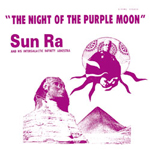|
|
 |
Dusted Reviews
Artist: Sun Ra Album: The Night of the Purple Moon Label: Atavistic Review date: Sep. 17, 2007 |

|
|
|
 |
Scarcity is the common denominator between the records that have become grails in Sun Ra’s bulging discography, but beyond that a myriad of factors come into play. Cosmic Tones For Mental Therapy sported a great name and an out of this world proto-dub recording technique developed when Skatalites were still recording around a room mic; Strange Strings substituted stringed thrift-shop acquisitions for the Arkestra’s usual instrumentation, with bracing results; Lanquidity was an improbable reach into the realm of smooth jazz-funk. The conventional wisdom about The Night Of The Purple Moon is that it, like the still MIA pair of late ’70s waxings for the Italian Horo label, is a highly listenable, small group session that coulda-woulda-shoulda broadened Ra’s audience if only people had heard it. But after a small pressing made in 1972 on Ra’s Saturn label, it passed into the collectors’ domain. Now that Atavistic has taken up the baton carried in the ’90s by Evidence records by resuming the reissue of the Saturn catalog, pipe dreams about what could have been can be swapped for the more tangible pleasure of listening to this charming record.
In 1970, when Ra made The Night Of The Purple Moon, he was in the midst of a major cosmic shift. After a spending the latter half of the ’60s making extremely far out music situated at the farthest fringes of free jazz, he started recording tunes again. In this regard, the quartet tracks that comprise the bulk of the album bear a strong resemblance to the organ combo excursion originally released as side one of My Brother The Wind II. Danny Davis and (on one track) John Gilmore play saxophone lines that would have sounded right twisting through the smoke in a suave lounge back in the day when Charles Earland and Jimmy Smith were jukebox stars; like those Hammond titans, Ra seasoned tunes like the slinky “Sun Earth Rock” and jubilant “Impromptu Festival,” with churchy harmonies, hard-swinging grooves, and catchy themes. James Stafford’s electric bass gives the rhythmic foundation an essential, idiomatic tightness that is undermined by Ra’s decision to have the saxophonists (mostly Gilmore) play drums; both men’s drumming is a bit slack, and when the band goes free on “A Bird’s Eye View Of Man’s World,” Gilmore sounds like he’s chasing an idea he can’t quite catch. The effect probably delighted Ra, who cherished paradoxes as a way of breaking out of conventional thinking; but the shamble factor makes it unlikely that this album could ever have muscled in on the B-3 titans’ airtime.
Another factor that adds to the record’s subtle aura of strangeness is Ra’s keyboard choice. Throughout he uses the RMI Rocksichord, an electric harpsichord to craft a spider-like web of mysterious echo and salty tone that reaches its apotheosis on the swaggering title tune. Two Mini-moogs join the Rocksichord on a trio of solo tracks that comprised the second half of side one. “Blue Soul” and “Narrative” are succinct and accessible, very much of a piece with the group performances. But on “Outside the Time Zone,” he ventures into atonality, which is compounded by vinyl crackle and distortion. The original tapes for this session are long gone, and Saturn used such low-rent pressing plants that even virgin copies like the one Atavistic used for this reissue were pretty noisy. But anyone who buys a pre-’80s Sun Ra record expecting hi-fi sound is either uninformed or afflicted with a serious learning disability; Ra was never terribly concerned with adhering to the conventions of audio fidelity.
This reissue is bolstered by four bonus tracks. One is an alternate version of “Love In Outer Space” that you might already know from Blast First’s Out There A Minute compilation. The other three are brief solo keyboard performances from 1964. By using distorted amplification and a percussive attack, Ra obtained sounds from a Wurlitzer electric piano that would fit right in on a Konono No. 1 record. They provide an early glimpse into his endless search for otherworldly sonorities.
By Bill Meyer
|







